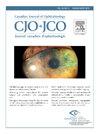Relative exophthalmos in facial nerve palsy
IF 2.8
4区 医学
Q1 OPHTHALMOLOGY
Canadian journal of ophthalmology. Journal canadien d'ophtalmologie
Pub Date : 2025-10-01
DOI:10.1016/j.jcjo.2025.02.017
引用次数: 0
Abstract
Objective
While ocular manifestations of facial nerve palsy, such as lagophthalmos are well known, there is limited knowledge on whether CN 7 palsy impacts globe positioning and its implications on symptoms and management. We hypothesize that CN 7 palsy is associated with ipsilateral exophthalmos.
Methods
A retrospective analysis of 500 patients diagnosed with facial nerve disorders, identified by ICD codes G51.0–G51.9, was conducted at a tertiary health care facility from January to November 2023. Patients were included if they had a diagnosis of unilateral facial nerve (CN 7) palsy and available computed tomography (CT) imaging after diagnosis. Patients under 18 years, those with bilateral CN 7 palsy, or with CT images of poor resolution were excluded. Axial position of the globe was measured on CT scans using 2 methods, both previously shown to correlate with Hertel exophthalmometry.
Results
Of the 500 charts reviewed, 55 patients met inclusion criteria. 55% (n = 30) of patients were male, and 58% (n = 32) had right-sided CN 7 palsy. The predominant etiology was acute Bell's palsy 76% (n = 42). CT measurements revealed a statistically significant relative exophthalmos on the side affected by CN 7 palsy, measuring an average of 0.89 mm (Method 1) and 0.92 mm (Method 2) (both methods p < .001).
Conclusions
Our study is the first to highlight changes in ocular globe position in CN 7 palsies. The observed exophthalmos highlights the importance of assessing globe position in ophthalmologic management of the disorder.
面神经麻痹的相对突出眼。
目的:面神经麻痹的眼部表现(如眼lagophthalmos)是众所周知的,但cn7麻痹是否影响眼球定位及其对症状和治疗的影响却知之甚少。我们假设cn7麻痹与同侧突眼有关。方法:回顾性分析2023年1月至11月在一家三级卫生保健机构诊断为面神经疾病的500例患者,ICD代码为G51.0-G51.9。如果患者被诊断为单侧面神经(CN 7)麻痹并在诊断后可用计算机断层扫描(CT)成像,则纳入该研究。排除18岁以下、双侧cn7麻痹或CT图像分辨率较差的患者。用两种方法在CT扫描上测量眼球的轴向位置,这两种方法之前都被证明与Hertel验眼术相关。结果:在500张图表中,55例患者符合纳入标准。55% (n = 30)为男性,58% (n = 32)为右侧cn7麻痹。主要病因为急性贝尔麻痹76% (n = 42)。CT测量显示,cn7麻痹一侧的相对突出具有统计学意义,平均为0.89 mm(方法1)和0.92 mm(方法2)(两种方法p < 0.001)。结论:我们的研究首次强调了cn7型麻痹患者眼球位置的变化。观察到的突出突出突出的重要性评估全球位置在眼科管理的障碍。
本文章由计算机程序翻译,如有差异,请以英文原文为准。
求助全文
约1分钟内获得全文
求助全文
来源期刊
CiteScore
3.20
自引率
4.80%
发文量
223
审稿时长
38 days
期刊介绍:
Official journal of the Canadian Ophthalmological Society.
The Canadian Journal of Ophthalmology (CJO) is the official journal of the Canadian Ophthalmological Society and is committed to timely publication of original, peer-reviewed ophthalmology and vision science articles.

 求助内容:
求助内容: 应助结果提醒方式:
应助结果提醒方式:


